Sea Drying Again Little Human You Once Helped Filling Sea You Helping Again
The country that brought a body of water back to life
(Epitome credit:
Taylor Weidman
)
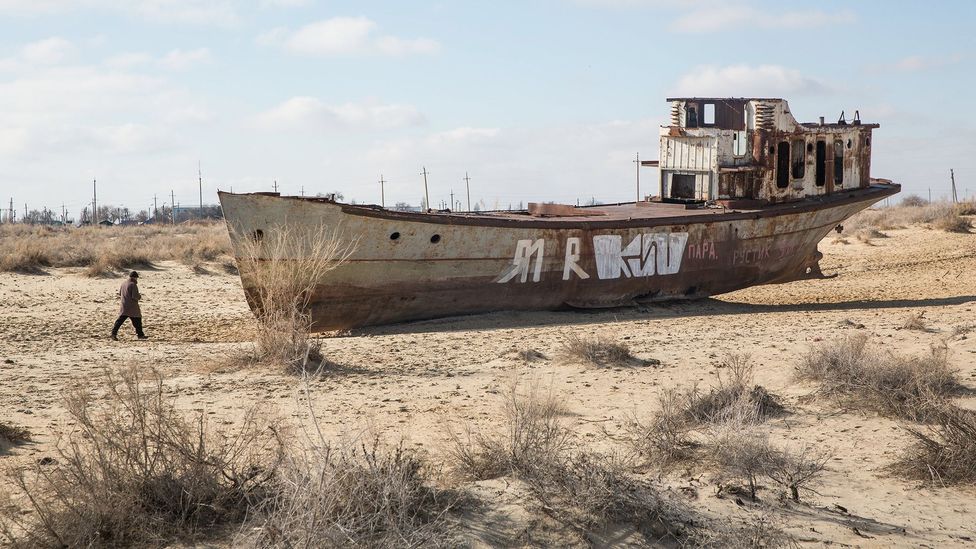
The Aral Bounding main is bringing new wealth to fishing villages in Republic of kazakhstan, just their neighbours on the reverse shore in Uzbekistan are suffering a very different fate.
F
For a young Madi Zhasekenov, summertime on the shoreline of the Aral Sea was an idyllic affair. His 3-calendar month school holidays were spent at the port virtually his abode in Aralsk, south-western Kazakhstan, interacting with fishermen hauling in their daily catch.
"We used to manner line-fishing lures from hooks and then we would stand forth the sea to catch fish," says Zhasekenov, who is now 58. "I used to take hold of pocket-sized and large fish, and we would feed the cats and dogs for fun."
But by the time he was 17, the h2o levels of the Aral Ocean had dropped and the salinity had risen so rapidly that the freshwater fish that once thrived there could no longer survive. One of the hardest moments for Zhasekenov was when he realised that he needed to buy fish for his family's daily meals.
"Nosotros didn't know how to purchase a fish because nosotros just always used to grab them," he said. "The first time I went to the market to buy it, it was just a very bad feeling."
You might also like:
• The fishing armada stranded in a desert
• How a city that floods is running out of h2o
• The deadly island abased by the Soviets
At the contrary end of the Aral Sea, the residents of Moynaq – a robust fishing hub in northern Uzbekistan that employed more 30,000 people – experienced a similar fate.
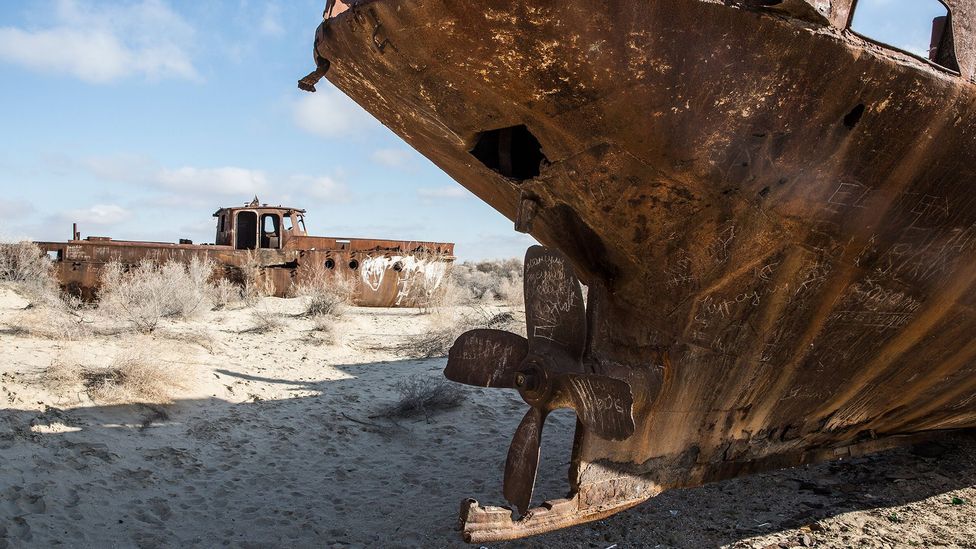
Rusting ships sit down in the desert in the one-time port in Moynaq, Uzbekistan (Credit: Taylor Weidman)
"I was v or six the last time I saw ships in the sea when we went pond," says Marat Allakuatov, a 47-year-old old resident of Moynaq.
Today, the seabed has completely stale out in the humming metropolis, leaving simply sandy common salt deposits and the rusting husks of abandoned fishing trawlers. The local economy has evaporated along with the water.
"Equally the bounding main disappeared, the people staying there became unemployed," says Allakuatov. He at present works in a hotel in Nukus, the capital of the commonwealth of Karakalpakstan, an democratic region of Uzbekistan that encompasses Moynaq. "The older generation officially lost their hope for the future."
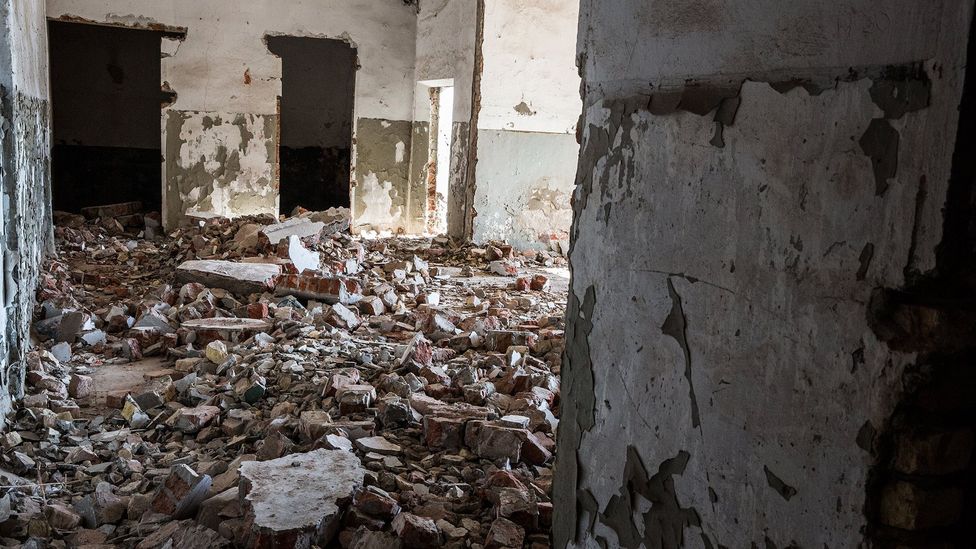
A onetime fish canning manufactory in Moynaq, previously a thriving fishing hub, has fallen into ruin (Credit: Taylor Weidman)
With their fisheries decimated, the communities these two men are part of at opposite ends of the bounding main faced similar dire fates in the 1990s.
Just more 2 decades on, their paths take diverged. Today, the North Aral Sea in Kazakhstan has been revived, with water and economic system returning to Aralsk. But the South Aral Sea in Uzbekistan is almost completely desiccated, and its residents are choking on the air.
How did the ii cities have such unlike outcomes?
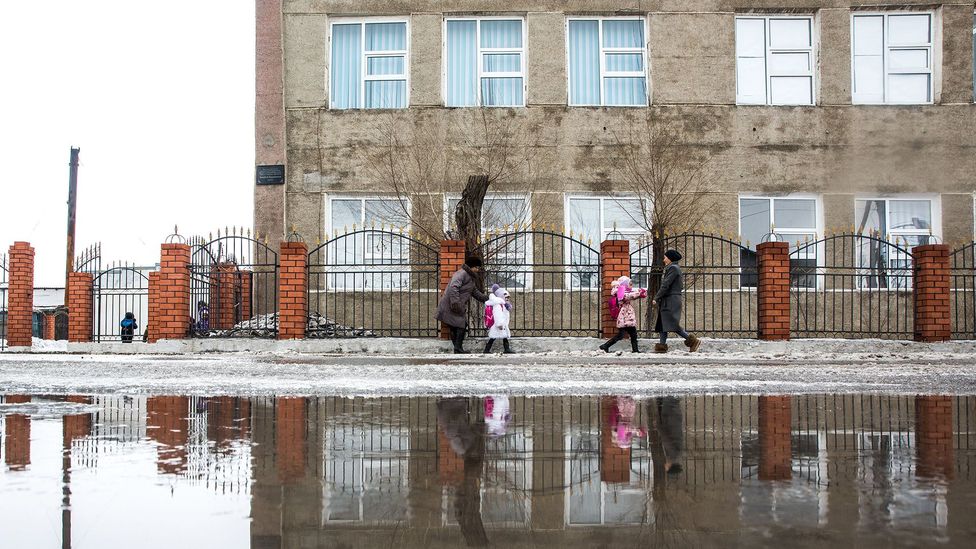
At the other side of the same ocean as Moynaq, the Kazakh city of Aralsk has undergone a very dissimilar fate (Credit: Taylor Weidman)
At more 67,000 sq km (26,000 sq miles), the Aral Ocean was one time the fourth-largest freshwater lake in the world. But the Soviet Union's uncompromising agricultural policies in the 1950s led to water from two rivers – the Amu Darya and the Syr Darya – being diverted abroad from the body of water to gargle Key Asia's desert steppes to boost cotton product. Water levels dropped and the once abundant populations of bream, carp and other freshwater fish dwindled with them.
Today, the sea is a 10th of its original size and has nigh split in two. Mimicking the shape of a splintered number eight, the Northward Aral Sea – the top half of the body of water – lies in Republic of kazakhstan. The Southward Aral Sea, which consist of a strip of water in the west and a dried-out basin in the e, sits in Uzbekistan.
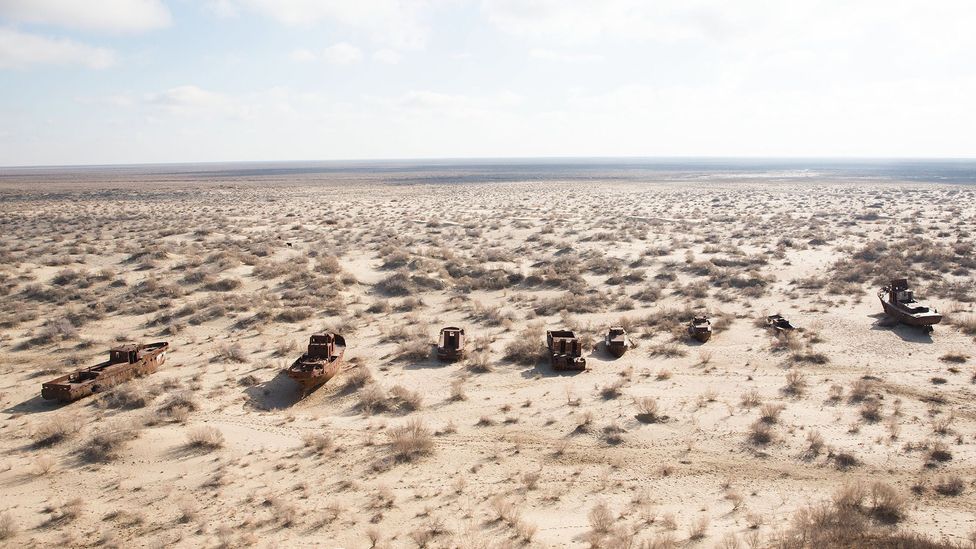
The Uzbek side of the Aral Sea has turned to desert (Credit: Taylor Weidman)
In the 1990s, both bodies of h2o seemed headed for similar outcomes. But that changed when the Earth Bank stepped in with an $87m (£66m) rescue projection in Kazakhstan.
This included constructing a 12km-long (7.five mile) dyke across the narrow channel that connects the North Aral Sea to its neighbour to the southward, with the aim of reducing the amount of water spilling out into the Due south Aral Sea. Improvements to existing channels of the Syr Darya river, which snakes northwards from Kazakhstan's Tian Shan Mountains, also helped to boost the flow of h2o into the N Aral Sea.
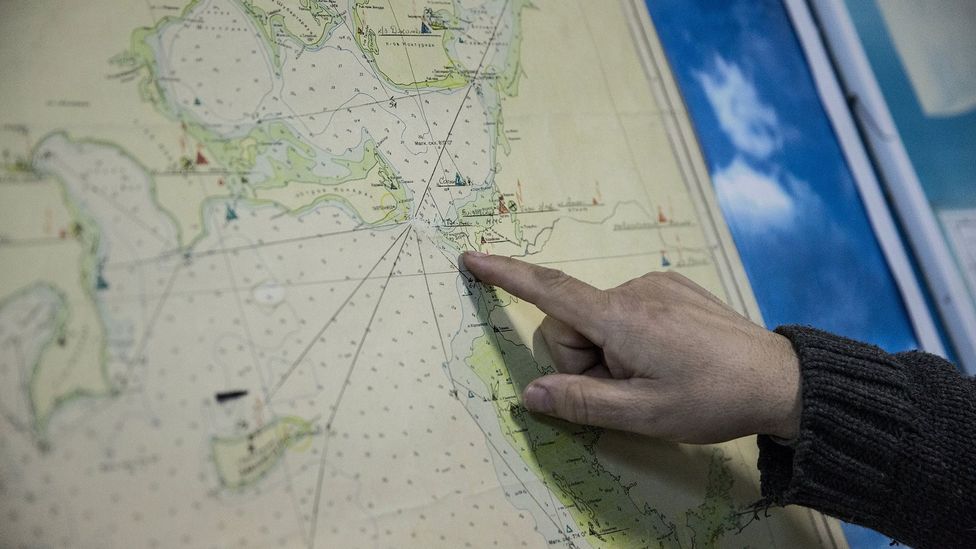
Kazakhstan'south 12km-long dyke, pointed out on a map here, saved part of the North Aral Ocean – by connecting it to the South Aral Body of water (Credit: Taylor Weidman)
Finished in the summer of 2005, the Kokaral dam – as the dyke is known – surpassed the Globe Bank's expectations, leading to an increase of 3.3m (10.8ft) in water levels after vii months, which scientists had previously calculated would have around 10 years.
"At that time, we were non expecting this much flow and the success has been astounding," says Masood Ahmad, the Earth Bank team leader who prepared and appraised the project in 2001.
The return of the North Aral Sea has fuelled a revival of the line-fishing industry in Aralsk. In 2006, the almanac fish catch totaled 1,360 tons, which comprised a majority of flounder – a saltwater species that the Kazakhs dislike. Past 2016, the Aralsk Fish Inspection Unit recorded 7,106 tons of fish as freshwater species accept returned, including pike-perch – which bring in a hefty price for local fishermen – breams, asp, and catfish.
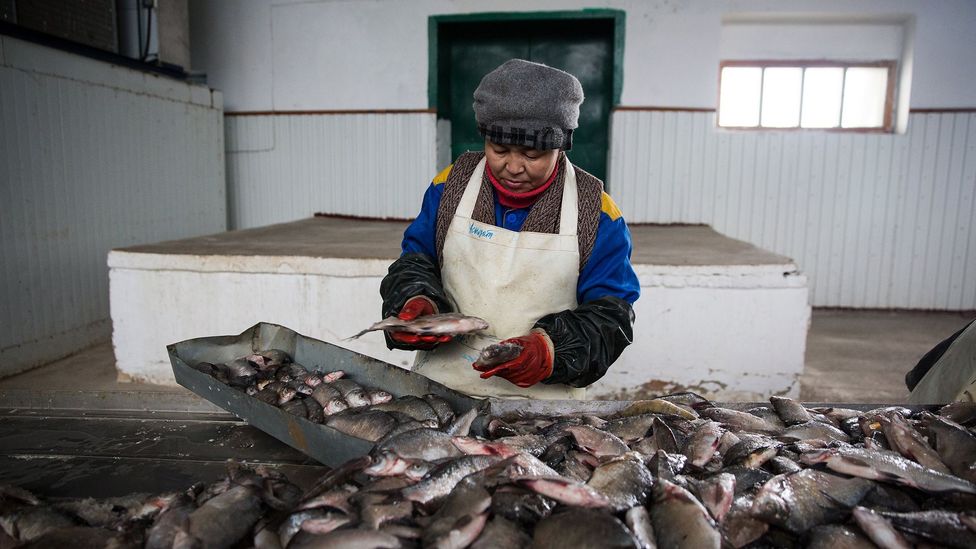
Thanks to the Northward Aral Bounding main's return, Aralsk's line-fishing industry has been revived (Credit: Taylor Weidman)
Mayhap surprisingly, the Kazakh government played a central part in this recovery process.
"Almost governments normally give priority to generating incomes, like improving irrigation to increase crop production or water management so that they can supply water to cities," says Ahmad. "Environment and ecology improvements are the last thing that governments requite priority to, but the Kazakhs did it."
Changing fortunes
For Aldanbek Kerinov, the return of the fisheries in the North Aral Sea has allowed him to modify careers. He was a taxi commuter 7 years ago, pulling in 3,000 to 5,000 tenge (£7-xi) a mean solar day.
Now the 27-yr-old works with his ii brothers out on the lake. In sub-zero weather in February, they retrieved virtually 20kg (44lb) of pike-perch from their nets submerged under the frozen surface of the Aral Bounding main. Extremely pop amidst Kazakhs, this fish sells for roughly 650 tenge (£1.45) per kilogram to fish factories and buyers.
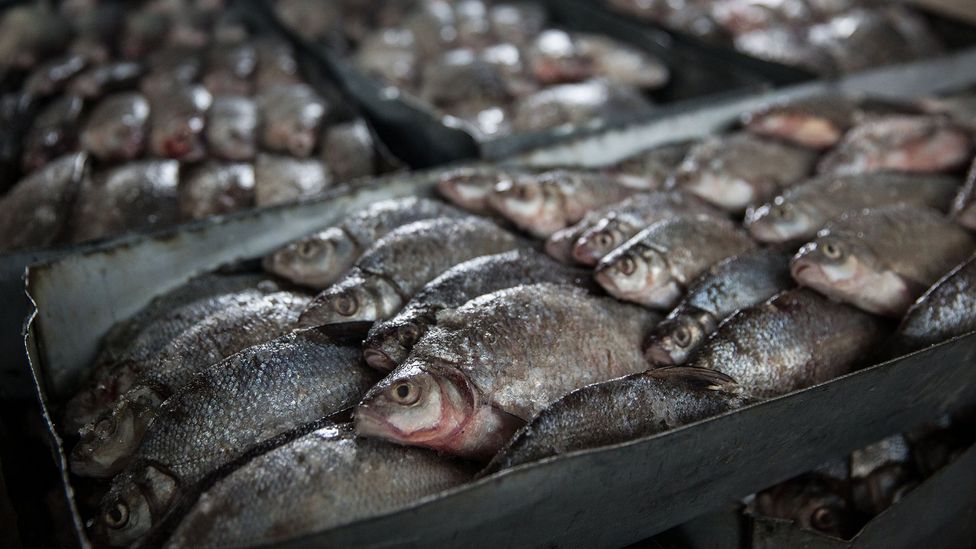
Now, local fishermen in Aralsk tin can sometimes bring in most £110 worth of fish in a single catch (Credit: Taylor Weidman)
"In the wintertime, sometimes we will grab near 50,000 tenge [worth of fish] per person" in a single take hold of, explains Kerinov. "So it would be 150,000 tenge (£335) for the iii of usa. We prefer to grab even only one freeway perch instead of driving a taxi."
Kerinov was too young to take seen the seawater lapping against the port walls of Aralsk. The shore currently sits about 20km (12 miles) from the town, which means a two-hr drive through the thick winter snow to accomplish it.
"We are dreaming that one mean solar day the sea would reach Aralsk and so nosotros don't have to drive so far," says Kerinov. "Every day, we would be able to go fishing just from our house."
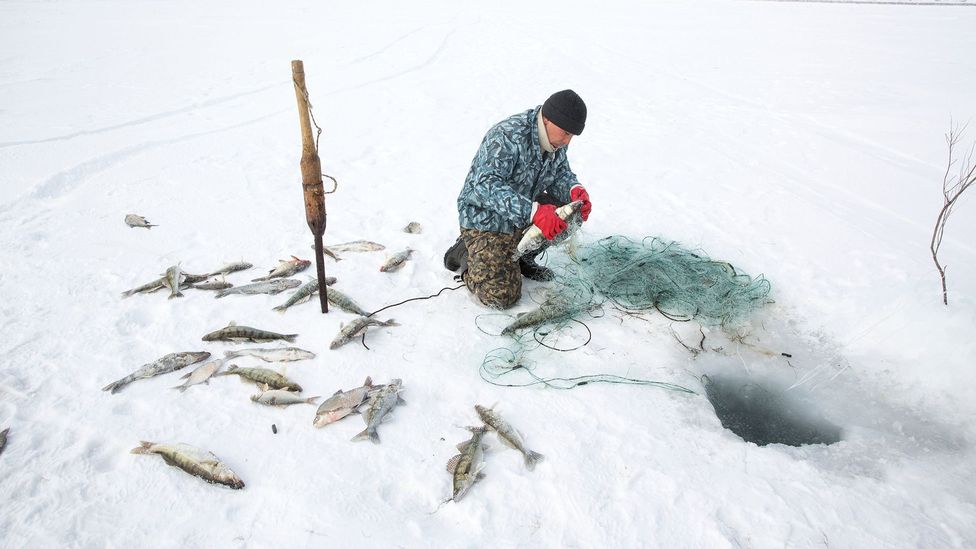
Fishing has returned year-round to the Kazakh side of the Aral Body of water, but locals nevertheless need to bulldoze 20km to accomplish the water once on their doorstep (Credit: Taylor Weidman)
According to Ahmad, this is a real possibility. Due to the improved water menses in the Syr Darya river, roughly 2.7 billion cubic metres (594 billion gallons) of water a year spills over the Kokaral dam and into the southern function of the bounding main.
"It spills over, information technology evaporates and it is lost," he says. "It does not have every bit much ecological value or benefit. Since the Kokaral dam was built in 2005, over thirty billion cubic metres to date has spilled from the Northern Aral Sea."
Raising the dyke walls by another four metres would aid to go along an additional 15 billion cubic metres of water in the North Aral Sea, he adds. This would extend the area covered by the sea, which currently measures 800sq km (300 sq miles), by another 400sq km (150 sq miles).
"It will increase by 50%," says Ahmad. "This will accept about four, five years."
Plans to do this were put forrad as part of a 2d phase of the Globe Banking company projection, but it has recently stalled. According to the World Bank the project is currently pending approval from the Kazakh government to motility forward.
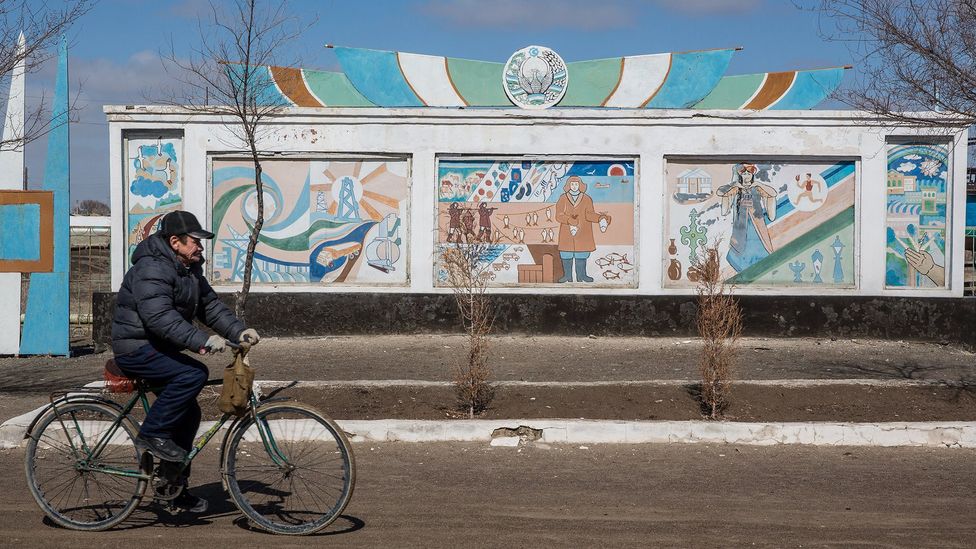
In Moynaq, Uzbekistan, which too once had a thriving fishing industry on the Aral Bounding main, the story has been very different (Credit: Taylor Weidman)
Beyond the edge in Uzbekistan, the story is very different. While the World Bank has worked on some projects to restore the existing lakes effectually the S Aral Body of water, such as Lake Sudoche, it has had less success. The primary obstacle appears to be the demand that Uzbeks have for it, as the Amu Darya river flows are used upstream for agricultural purposes and does not have enough water menstruum to fill upward the S Aral Sea.
Greater reliance on cotton fiber production for income has as well hindered attempts to restore the South Aral Sea to its former glory. From 1930 to 1990, Uzbekistan provided more two-thirds of the cotton produced in the Soviet Wedlock. It ranked fifth out of ninety cotton-producing countries, and information technology was the second-largest exporter of cotton fibre to the United states of america. Today, Uzbekistan is still the fifth-biggest cotton exporter in the globe after the United states of america, India, Brazil, and Australia.
"The regime could have done the rehabilitation of the Southern Aral Sea but and so they would have put a lot farmers who are using h2o for irrigation out of employment," says Ahmad. "Yous cannot give up something that gives you income."
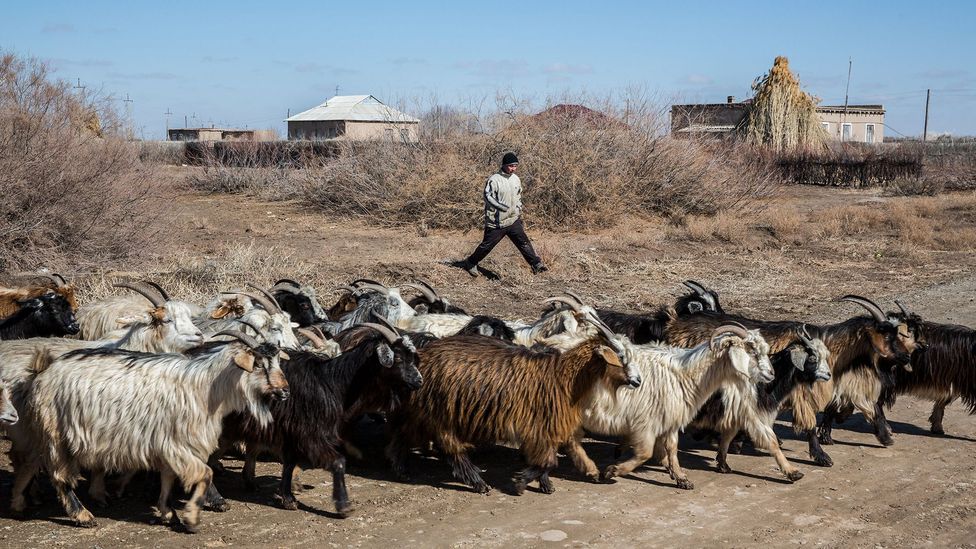
Rehabilitation of the South Aral Sea has been complicated by farmers' need of water for irrigation (Credit: Taylor Weidman)
In 2015, the eastern basin of the South Aral Sea completely stale up and the water never returned.
"Information technology's a pity," laments Allakuatov. "I think the economical situation is more of a priority right now than keeping the water or nature or environment."
Salt storms
There are still jobs available in Moynaq. The stale-up seabed has provided new opportunities for natural gas companies hoping to tap into the resources beneath the desiccated ground.
But although the exposed sea floor has allowed this new industry to hold unemployment in check, it is also creating new worries for the city's residents.
With such a big torso of water now greatly reduced in size, this has afflicted the climate in the region, irresolute temperatures and rainfall. The exposed seabed too contains a lot of salt and sediment, while the use of fertilisers by cotton fiber producers over the decades has concentrated these harmful chemicals in the soil.

The dust, common salt and chemicals now coming off of the Aral Sea'south dried-up seabed are causing health problems for locals (Credit: Taylor Weidman)
When whipped up by stiff winds, choking grit storms are formed, enveloping nearby settlements. Studies have linked sustained exposure to this dust to an increase in respiratory diseases in people living nearby.
"There is dust coming up from the bed of the Aral Sea, so this salt is spreading everywhere – non but in the territory of Karakalpakstan, just also in the northwest part of Turkmenistan," says Allakuatov. "The people are suffering from the salty state."
Across the edge in Aralsk, the sea continues to exist at the heart of Zhasekenov's life. As the manager of the Aralsk Regional Museum and Fishermen Museum – a position he inherited from this late father – Zhasekenov knows every bit of history apropos the sea, and dreams of the water flowing back to the old port, where his museum is located.
For now, he is happy that the return of the North Aral Sea has revived some erstwhile pastimes, and remains optimistic that the bounding main volition be restored to its previous glory.
"Today, if I have a shortcut, the body of water is only 14km (8.seven miles) abroad and I volition exist able to go to some fishermen's home. In that location, the fishermen will give united states some fish. This reminds me of my childhood," he says. "I believe I will see the h2o in the port again."
Serik Dyussenbayev contributed reporting to this story.
Dene-Hern Chen and Taylor Weidman were supported by a grant from the Pulitzer Middle on Crisis Reporting for this story.
Bring together 900,000+ Futurity fans by liking u.s.a. on Facebook, or follow usa on Twitter or Instagram.
If you liked this story, sign up for the weekly bbc.com features newsletter, chosen "If Y'all Only Read 6 Things This Week". A handpicked selection of stories from BBC Future, Culture, Capital, and Travel, delivered to your inbox every Friday.
Source: https://www.bbc.com/future/article/20180719-how-kazakhstan-brought-the-aral-sea-back-to-life
0 Response to "Sea Drying Again Little Human You Once Helped Filling Sea You Helping Again"
إرسال تعليق